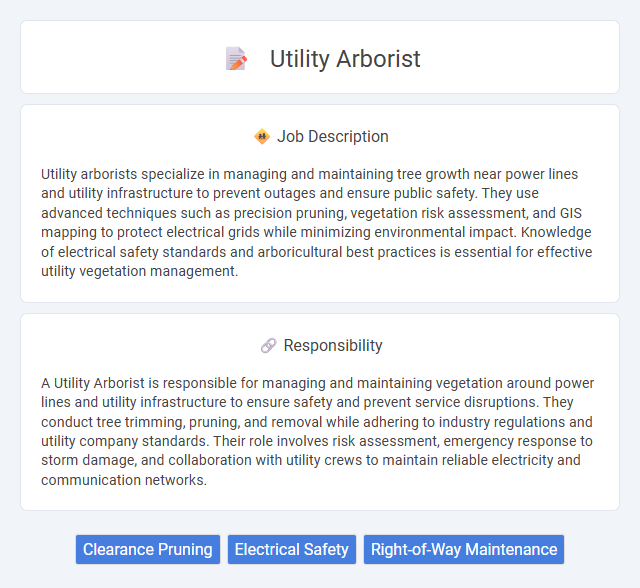
Utility arborists specialize in managing and maintaining tree growth near power lines and utility infrastructure to prevent outages and ensure public safety. They use advanced techniques such as precision pruning, vegetation risk assessment, and GIS mapping to protect electrical grids while minimizing environmental impact. Knowledge of electrical safety standards and arboricultural best practices is essential for effective utility vegetation management.
People with a strong tolerance for physical labor and working outdoors in various weather conditions are likely suitable for a Utility Arborist role. Those who may experience difficulty include individuals with chronic health issues, limited mobility, or fear of heights due to the job's demanding and sometimes hazardous nature. A willingness to adhere to safety protocols and work irregular hours might also influence suitability for this profession.
Qualification
Utility arborists require specialized training in tree biology, pruning techniques, and utility line clearance standards to ensure safety and compliance. Certifications such as the International Society of Arboriculture (ISA) Utility Specialist credential and Occupational Safety and Health Administration (OSHA) safety training are often essential. Strong knowledge of electrical hazards and experience with rigging and climbing equipment are critical qualifications for effective job performance.
Responsibility
A Utility Arborist is responsible for managing and maintaining vegetation around power lines and utility infrastructure to ensure safety and prevent service disruptions. They conduct tree trimming, pruning, and removal while adhering to industry regulations and utility company standards. Their role involves risk assessment, emergency response to storm damage, and collaboration with utility crews to maintain reliable electricity and communication networks.
Benefit
Utility arborist jobs likely offer significant benefits including competitive salaries and comprehensive health insurance packages. Employees may also frequently receive retirement plan options and opportunities for overtime pay due to the nature of utility work schedules. Job stability and hands-on experience with advanced tree management technology contribute to long-term career growth prospects in this field.
Challenge
Utility arborist roles likely involve navigating complex environments where power lines and vegetation intersect, requiring precise tree pruning to minimize outages and hazards. Challenges may stem from unpredictable weather conditions and difficult terrain that could increase risks while maintaining safety standards. The job probably demands continual adaptation to evolving industry regulations and advanced equipment to effectively manage vegetation around critical infrastructure.
Career Advancement
Utility arborists specializing in the maintenance and management of trees near power lines have significant opportunities for career advancement through certifications such as the International Society of Arboriculture's Certified Utility Specialist (CUS) credential. Progression often leads from field technician roles to supervisory or project management positions, where expertise in vegetation management strategies and safety compliance becomes critical. Advanced roles also involve collaboration with utility companies to develop sustainable practices that minimize service interruptions and environmental impact.
Key Terms
Clearance Pruning
Utility arborists specialize in clearance pruning to ensure vegetation does not interfere with power lines, minimizing the risk of outages and safety hazards. They use precise cutting techniques to maintain safe distances between tree branches and electrical infrastructure, complying with industry standards and local regulations. Effective clearance pruning enhances grid reliability while promoting tree health through targeted trimming methods.
Electrical Safety
Utility arborists specialize in managing and maintaining trees near power lines to ensure electrical safety and prevent outages. They employ precise pruning techniques to avoid contact with energized wires, reducing the risk of electrical hazards and ensuring compliance with industry safety standards. Their role is critical in minimizing fire risks and protecting public infrastructure from tree-related electrical faults.
Right-of-Way Maintenance
Utility arborists specializing in Right-of-Way (ROW) maintenance ensure the safe clearance of vegetation near power lines, reducing the risk of outages and improving grid reliability. They perform precise tree trimming and removal based on utility regulations and environmental guidelines, prioritizing public safety and infrastructure protection. Expertise in identifying hazardous trees, using specialized equipment, and understanding local utility standards is critical for effective ROW management.
 kuljobs.com
kuljobs.com